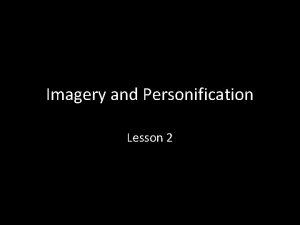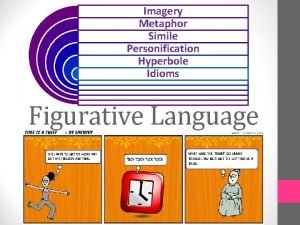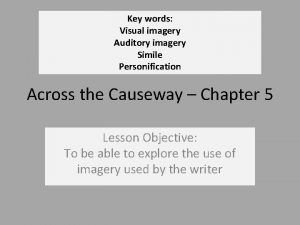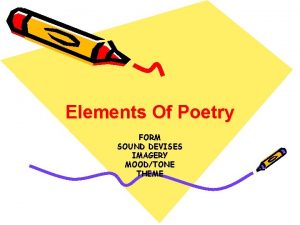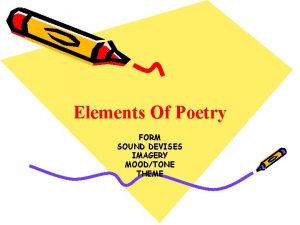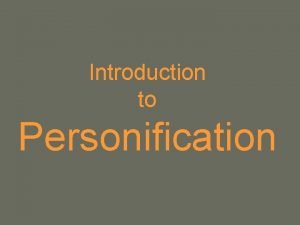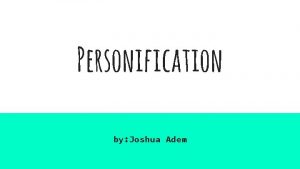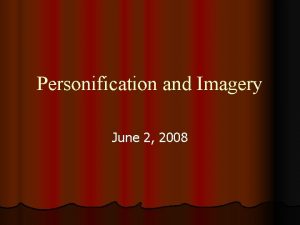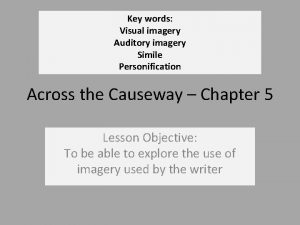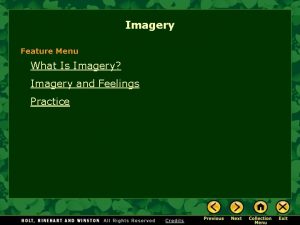Imagery and Personification Lesson 2 Introduction to Poetry

















- Slides: 17

Imagery and Personification Lesson 2

“Introduction to Poetry” by Billy Collins I ask them to take a poem and hold it up to the light like a color slide or press an ear against its hive. I say drop a mouse into a poem and watch him probe his way out, or walk inside the poem's room and feel the walls for a light switch. I want them to waterski across the surface of a poem waving at the author's name on the shore. But all they want to do is tie the poem to a chair with rope and torture a confession out of it. They begin beating it with a hose to find out what it really means.

What is Imagery? • Word or series of words that refers to any sensory experience (sight, sound, smell, touch or taste), helping to create a visceral experience for the reader. • Can you find all the imagery in “Introduction to Poetry”?

“Introduction to Poetry” by Billy Collins I ask them to take a poem and hold it up to the light like a color slide or press an ear against its hive. I say drop a mouse into a poem and watch him probe his way out, or walk inside the poem's room and feel the walls for a light switch. I want them to waterski across the surface of a poem waving at the author's name on the shore. But all they want to do is tie the poem to a chair with rope and torture a confession out of it. They begin beating it with a hose to find out what it really means. Key: • Touch • Taste • See • Hear • Smell

Background Poets use figurative language to help a reader imagine the events and emotions described in a poem. Imagery, a word or series of words that refers to any sensory experience (sight, sound, smell, touch, or taste), helps create a visceral experience for the reader. Personification is a figure of speech in which a thing, animal, or abstract term (truth, death, the past) takes on human qualities. To comprehend Emily Dickinson’s poetry, the reader must understand the importance of figurative language as a way to suggest what cannot be literally stated. To appreciate her work, one must forgo readings that view truth as black or white. Dickinson’s poetry is consciously mysterious and elliptical. The reader must attempt to use Dickinson’s own logic, remembering that “Much Madness is divinest Sense – / To a discerning Eye –. ”

Example of Imagery I felt a Funeral, in my Brain, And Mourners to and fro Kept treading—till it seemed That sense was breaking through— And when they all were seated, A Service like a Drum— Kept beating—till I thought My Mind was going numb— And then I heard them lift a Box And creak across my Soul With those same Boots of Lead, again, Then Space—began to toll… -#280 by Emily Dickinson

“Old Men Playing Basketball” The heavy bodies lunge, the broken language of fake and drive, glamorous jump shot slowed to a stutter. Their gestures, in love again with the pure geometry of curves, rise toward the ball, falter, and fall away. On the boards their hands and fingertips tremble in tense little prayers of reach and balance. Then, the grind of bone and socket, the caught breath, the sigh, the grunt of the body laboring to give birth to itself. In their toiling and grand sweeps, I wonder, do they still make love to their wives, kissing the undersides of their wrists, dancing the old soft-shoe of desire? And on the long walk home from the VFW, do they still sing to the drunken moon? Stands full, clock moving, the one in army fatigues and houseshoes says to himself, pick and roll, and the phrase sounds musical as ever, radio crooning songs of love after the game, the girl leaning back in the Chevy’s front seat as her raven hair flames in the shuddering light of the outdoor movie, and now he drives, gliding toward the net. A glass wand of autumn light breaks over the backboard. Boys rise up in old men, wings begin to sprout at their backs. The ball turns in the darkening air. BY B. H. FAIRCHILD

What is Personification? • A figure of speech in which a thing, animal, or abstract term (think truth, death, the past) takes on human qualities

Personification Example #1 The Sky is low—the Clouds are mean. A Travelling Flake of Snow Across a Barn or through a Rut Debates if it will go— A Narrow Wind complains all Day How some one treated him Nature, like Us is sometimes caught Without her Diadem. -#1075 by Emily Dickinson

Personification Example #2 “April Rain Song” Let the rain kiss you. Let the rain beat upon your head with silver liquid drops. Let the rain sing you a lullaby. The rain makes still pools on the sidewalk. The rain makes running pools in the gutter. The rain plays a little sleep-song on our roof at night— And I love the rain. BY LANGSTON HUGHES

Personification Example #3 The Wind—tapped like a tired Man— And like a Host—”Come in” His Countenance—A Billow— I boldly answered—entered then His Fingers, as He passed My residence within Let go a music—as of tunes Blown tremulous in Glass— A Rapid—footless Guest— To offer whom a Chair He visited—still flitting— Were as impossible as hand Then like a timid Man A Sofa to the Air— Again, He tapped—’twas flurriedly— And I became alone— No Bone had He to bind Him— -#436 by Emily Dickinson His Speech was like the Push Of numerous Humming Birds at once From a superior Bush—

Test yourself! Get into groups of three, • Find all instances of imagery in “The moon is distant from the sea” • Find all instances of personification in “After great pain a formal feeling”

The Moon is distant from the Sea— • Read about the relationship between the moon and the sea, the tides and the monthly lunar cycle • How does the relationship between the sea parallel that between the mysterious “Signor” and the speaker’s heart?

“The Moon is Distant from the Sea” The Moon is distant from the Sea -And yet, with Amber Hands -She leads Him -- docile as a Boy -Along appointed Sands -He never misses a Degree -Obedient to Her Eye He comes just so far -- toward the Town -Just so far -- goes away -Oh, Signor, Thine, the Amber Hand -And mine -- the distant Sea -Obedient to the least command Thine eye impose on me – - #429

WRITING EXERCISE!

Personification/Imagery Poem • Write an eight line poem of your own in which you speak about something that could cause great pain (i. e. breaking up with your boyfriend; losing a basketball game; losing a loved one. ) Feel free to make it humorous or sarcastic in tone. • Use personification and imagery to make the poem stronger. • Type up and bring to next class period.

Homework • Read your assigned poem for the Prezi presentation. Circle all instances of imagery and underline all instances of personification in the poem. Begin writing the “imagery” and “theme” sections for your presentation. Write about how the poet’s use of imagery makes theme of the poem stronger. To turn in: • Your marked up poem highlighting imagery and personification • Turn in a screen shot of your “Imagery” and “Theme” sections of your Prezi presentation • Typed Imagery/Personification Poem
 The moon personification
The moon personification Introduction to poetry סיכום
Introduction to poetry סיכום Simile metaphor and imagery
Simile metaphor and imagery Example of auditory imagery
Example of auditory imagery Auditory imagery examples
Auditory imagery examples Imagery elements of poetry
Imagery elements of poetry Poem with sound devices
Poem with sound devices Sample haiku
Sample haiku A dream within a dream tpcastt
A dream within a dream tpcastt Elements of poetry imagery
Elements of poetry imagery Explain the elements of poetry
Explain the elements of poetry Imagery in poetry
Imagery in poetry Tactile imagery definition
Tactile imagery definition Alliteration poetic device
Alliteration poetic device Narrative poems by shel silverstein
Narrative poems by shel silverstein Wind yells while blowing
Wind yells while blowing Personification for desert
Personification for desert Poetry character cavalier
Poetry character cavalier
